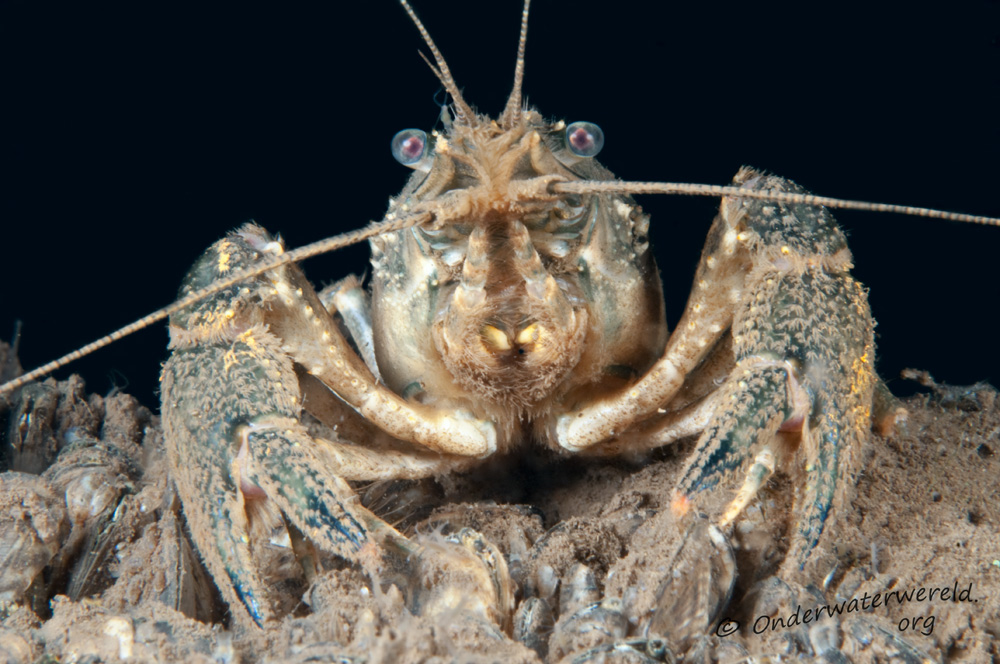

Orconectes limosus, de gevlekte Amerikaanse rivierkreeftOf de bruine kreeft of de gevlekte kreeft maar laten we het houden op de gevlekte Amerikaanse rivierkreeft. Dit schijnt de officiële Nederlandse naam te zijn. Hij werd voor het eerst in 1890 geïntroduceerd in, Polen. Met andere woorden, hij werd expres uitgezet. Waarom? Omdat er gegeten moest worden en de Europese kreeft (Astacus astacus) die tot dan gegeten werd, sterk achteruit ging. Helaas was deze introductie een van de oorzaken van de verdere achteruitgang van de Europese kreeft.
De Amerikaanse rivierkreeft is namelijk drager van de kreeftenpest. Zelf heeft hij hier geen last van maar voor de Europese kreeft is de kreeftenpest dodelijk. Dit is meteen ook zijn grootste probleem, verder heeft de gevlekte Amerikaanse kreeft niet zo heel veel invloed op zijn omgeving en het onderwaterleven. Als voedselvoorziening bleek hij ook niet helemaal geschikt te zijn. De Amerikaanse rivierkreeft blijft vrij klein en heeft kleine scharen. Er zit dus simpelweg te weinig vlees aan. Omdat deze kreeft het niet zo nauw neemt met waterkwaliteit en leefomgeving heeft hij zich vrij snel sterk uit kunnen breiden, daarom worden er nu maatregelen genomen om de Europese kreeft niet uit te laten sterven in Nederland, hij komt nog maar op een plaats voor.
Inmiddels zijn er al meerdere uitheemse kreeftensoorten in Nederland gevonden, ook allemaal uit Amerika. Daar waar andere kreeftensoorten verschijnen is het meestal snel gedaan met de gevlekte Amerikaanse rivierkreeft. Hij wordt verdreven en de nieuwe soort neemt het territorium over. Helaas zijn deze nieuwe soorten ook drager van de kreeftenpest zodat herintroductie van de Europese kreeft zinloos is.
De gevlekte Amerikaanse rivierkreeft is herkenbaar aan de oranje punten van de scharen, achter de oranje punten een zwarte band. Ze hebben stekels op de wangen. De wijnrode vlekken op het achterlijf die vaak als determinatiekenmerk genoemd worden hoeven niet altijd aanwezig te zijn of ze verschijnen pas op latere leeftijd. In de Boschmolenplas is het tot nog toe simpel, de Amerikaanse kreeft is de enige soort die er voorkomt maar misschien kunnen we vroeg of laat toch een andere soort verwachten.

Tekst en Foto’s Silvia Waajen
Also known as the Eastern Crayfish or Delcore Crayfish but lets say the Spiny Cheek Crayfish. This seems to be the official popular name. He was first introduced in Poland in 1890. In other words, he was deliberately introduced. Why? Because there had to be eaten and the Noble Crayfish (Astacus astacus), eaten till then was rapidly declining. Unfortunately this introduction was one of the causes of the further declining of the Noble Crayfish. The Spiny-Cheek Crayfish is carrier of the Crayfish plague. It doesn’t effect the Spiny-Cheek Crayfish himself but it is deadly for the Noble Crayfish. This is also his biggest problem, there isn’t that much influence on his surroundings and the under water life. He wasn’t of much use either for the food supply. The Spiny Cheek Crayfish stays small and has small claws. There is simply to little meat on it. Because this Crayfish doesn’t care about water quality and habitat there was a rapid, big expansion. At this time there are measurements in the Netherlands for saving the Noble Crayfish for extinction. There is only one place left where the Noble Crayfish lives. Meanwhile there are other exotic Crayfish species found in the Netherlands, also all coming from America. The Spiny Cheek Crayfish will rapidly disappear there where one of the other species appears. He will be driven out of his habitat and the new species takes over. Unfortunately these new species are also carrier of the Crayfish plague so reintroduction of the Noble Crayfish is useless. The Spiny Cheek Crayfish is recognizable by orange tops of the claws. Behind these orange tops a black band. They have spines on their cheeks. The wine red spots on the abdomen, often mentioned for identification, are not always there or appear only on later age. Until now, in the Boschmolenplas it’s simple, the Spiny Cheek Crayfish is the only species living here but maybe sooner or later we can expect another Crayfish species.
Zorgeloos duiken en snorkelen begint bij Scuba Adventures Europe. Wij helpen jou de onderwaterwereld te ontdekken met een duikuitrusting die naadloos aansluit op jouw wensen en behoeften.
In onze online en offline duikwinkels vind je als duiker alle benodigdheden om van iedere duik een onvergetelijke ervaring te maken.